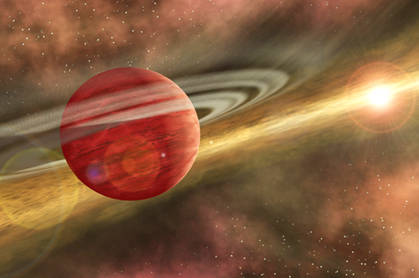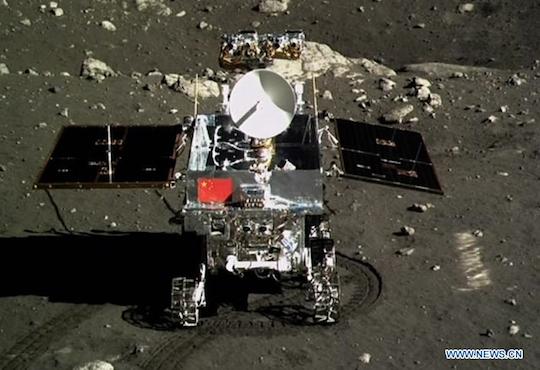This article is more than 1 year old
2013: A Space Odyssey - a cosmological review of the year
Asteroids 'n' comets, our new home Mars and the adventures of Jade Rabbit
Mmmm...it's not beer, but...
In an effort to stop himself from choking, Parmitano drank all the potable water in his "drink bag", thinking that was a likely source of the leak, but to no avail. The astronaut had to fight his way back into the station, ending up with the new record for the shortest spacewalk at just 92 minutes. He later blogged the utter bladder-weakening terror of the experience:
The water covers my nose – a really awful sensation that I make worse by my vain attempts to move the water by shaking my head. By now, the upper part of the helmet is full of water and I can’t even be sure that the next time I breathe I will fill my lungs with air and not liquid.
To make matters worse, I realise that I can’t even understand which direction I should head in to get back to the airlock. I can’t see more than a few centimetres in front of me, not even enough to make out the handles we use to move around the station.
The only idea I can think of is to open the safety valve by my left ear: if I create controlled depressurisation, I should manage to let out some of the water, at least until it freezes through sublimation, which would stop the flow.
But making a ‘hole’ in my spacesuit really would be a last resort.

PICTURES OF THE YEAR: Artist's conception of an enormous exoplanet with such
an improbably large orbit around its host star that it could turn cosmological theory
on its head. Full story here.
And the edge-of-seat stuff for the ISS may not be over yet. Despite the fact that NASA said on the station's 15th birthday that the orbiting lab was good for another 15 years, it's seeing out the year with problems in those pesky ammonia coolant loops again. The station has had to go into partial shutdown as one of the two systems stopped working unexpectedly, since the remaining loop is not powerful enough to cool the ISS by itself.
To sort out the faulty pump module at fault, NASA is sending the current ISS crew out on a series of emergency spacewalks on December 21, 23 and even Christmas Day. 'Nauts Rick Mastracchio and Mike Hopkins have been tapped for the job of replacing the module, which has a faulty valve, with a spare that's stowed on an external platform. Those who need a break from the family squabbles over the yuletide season can catch the extra-vehicular activities on NASA TV.
Run Rabbit, run Rabbit, run, run, run
Speaking of really, really old spacecraft, the Voyager craft has finally gone where no-one has gone before, outside our solar system. By March, the 35-year-old probe was showing the first signs of having exited the heliosphere - the region of the Sun's influence that extends at least 13 billion kilometres beyond all the planets in our Solar System.
While there's no exact markers for this unexplored territory, boffins felt it likely that Voyager was coming close to the line into interstellar space in the summer, as it had felt charged particles disappearing as they zoom away along the Sun's magnetic field and cosmic rays from outside zooming in.
Finally, in September, NASA engineers felt confident enough to confirm that the craft had really left the vicinity and become the first manmade object to travel beyond our home system. Voyager project scientist Ed Stone said:
In leaving the heliosphere and setting sail between the stars, Voyager has has joined the other historic journeys of exploration such as the first circumnavigation of the Earth or the first footprint on the Moon. This historic step is even more exciting because it marks the beginning of a new era of exploration for Voyager: the exploration between stars.

PICTURES OF THE YEAR: China's Jade Rabbit rover takes a selfie on the Moon.
And finally, this was also the year that India and China made some giant leaps into spacefaring status. In a frugal mission to Mars, India has sent the Mars Orbiter Mission (MOM) probe, also known as Mangalyaan, on its way to the Red Planet at the economical cost of just $74m.
MOM blasted off in early November into an Earth orbit that would help provide the juice to send it on its way into Solar System. Since they didn't spend a lot of money, India's Space Research Organisation's plan was to rev up in the Earth's orbit and slingshot off into space.
The plan was a good one too, despite a momentary hitch in its ever-increasing orbits, the Mangalyaan cleared the Earth at the start of the month and set off with its nose pointed in the general direction of Mars. The orbiter has already set the record for the farthest object sent into space by India, when it passed the Moon.
Not to be outdone, China decided to land on the Moon with its first lunar rover - Yutu or the Jade Rabbit. The name, chosen by an online poll, compliments Yutu's place in the country's lunar missions, which are all named after Chang'e, the moon goddess whose pet was named Yutu. The rover was announced as part of the Chang'e-3 lunar probe mission and launched shortly thereafter. On the 16th of December, the rover was pictured with its wheels on the lunar surface after a safe landing. ®
